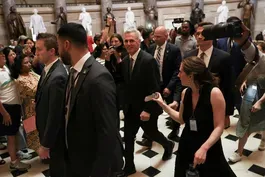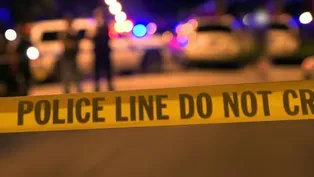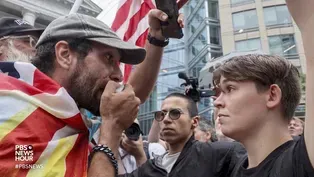
Purdue Pharma family protected from lawsuits in settlement
Clip: 5/31/2023 | 7m 49sVideo has Closed Captions
Purdue Pharma family protected from lawsuits in exchange for addiction treatment funding
A court ruled the owners of Purdue Pharma, the Sackler family, will be protected from civil lawsuits linked to the opioid crisis in exchange for a $6 billion settlement. Purdue, which filed for bankruptcy in 2019 amid thousands of lawsuits, made drugs like OxyContin and is blamed for fueling the opioid epidemic. William Brangham discussed the settlement with Aneri Pattani of KFF Health News.
Problems with Closed Captions? Closed Captioning Feedback
Problems with Closed Captions? Closed Captioning Feedback
Major corporate funding for the PBS News Hour is provided by BDO, BNSF, Consumer Cellular, American Cruise Lines, and Raymond James. Funding for the PBS NewsHour Weekend is provided by...

Purdue Pharma family protected from lawsuits in settlement
Clip: 5/31/2023 | 7m 49sVideo has Closed Captions
A court ruled the owners of Purdue Pharma, the Sackler family, will be protected from civil lawsuits linked to the opioid crisis in exchange for a $6 billion settlement. Purdue, which filed for bankruptcy in 2019 amid thousands of lawsuits, made drugs like OxyContin and is blamed for fueling the opioid epidemic. William Brangham discussed the settlement with Aneri Pattani of KFF Health News.
Problems with Closed Captions? Closed Captioning Feedback
How to Watch PBS News Hour
PBS News Hour is available to stream on pbs.org and the free PBS App, available on iPhone, Apple TV, Android TV, Android smartphones, Amazon Fire TV, Amazon Fire Tablet, Roku, Samsung Smart TV, and Vizio.
Providing Support for PBS.org
Learn Moreabout PBS online sponsorshipGEOFF BENNETT: A federal appeals court has ruled that the billionaire owners of Purdue Pharma, the Sackler family, will be protected from civil lawsuits linked to the opioid crisis in exchange for a $6 billion settlement.
Purdue, which filed for bankruptcy in 2019 amid thousands of lawsuits, made drugs like OxyContin and is blamed for fueling the opioid epidemic.
William Brangham has more.
WILLIAM BRANGHAM: Geoff, Purdue's opioid sales earned the Sackler family billions of dollars.
And the $6 billion that they will pay in this settlement will be given to state, cities and individuals harmed by opioid addiction and overdoses.
It also requires that the Sacklers give up control of Purdue Pharma.
In total drug manufacturers, pharmacies and distributors have pledged around $54 billion to state, local and tribal governments for their respective role in the opioid epidemic.
So, to understand where that money might be spent, we are joined by Aneri Pattani.
She is tracking all of this for KFF Health News.
Welcome to the program.
Just remind us of the contours of this deal, the Sackler settlement, what it means for the Sacklers and what it means for the people who are suing them.
ANERI PATTANI, KFF Health News: So, this deal has been in the works for a long time.
There's been almost a year that folks have been waiting on this next step in the bankruptcy.
And with the federal judge in New York clearing this for the next round, what it means is that the Purdue Pharma bankruptcy for the company can move forward.
And when the bankruptcy moves forward, for people who filed lawsuits for the governments, state and local governments, they will be getting payouts from a total of $6 billion about.
And what it means for the Sacklers is that the individual Sackler family members are protected from any lawsuits against them.
So that was sort of the trade-off in moving this deal forward that the judge OKed.
WILLIAM BRANGHAM: I mean, it seems like there are these two competing forces here, the very demonstrable anger against the Sackler family, for which there's a good documentary evidence that they knew how bad this crisis was and yet kept going forward, and yet also this desire on behalf of all these states and communities to get that money to try to ameliorate.
That's a very difficult tension to navigate.
ANERI PATTANI: Yes, I think I have been hearing this from a lot of folks, where people have been waiting for this bankruptcy to move forward for a long time.
Individual families want the money, right?
I hear from grandparents who are raising their grandkids because their sons or daughters died of the opioid crisis.
And those bills are coming in now, right, like the caring for them, their school, their health, whatever it is, families that are dealing with funeral costs for people who have died of overdoses, so they need the money now.
And then there -- you talk about the governments that want to start addiction treatment programs or recovery housing.
But, at the same time, the way this money is moving forward and actually getting out to people is by protecting the Sackler family from any personal responsibility.
And those same family members who want the money and the same communities that need it also feel like there should be some personal responsibility for what happened.
WILLIAM BRANGHAM: Right.
And, like, I guess that's just what they're going to have to live with now, that the money comes in it comes with this other stipulation.
As you and many others have been reporting, the Sackler money is just part of this other bit bigger pot of money from a lot of different -- from pharmacies, from distributors, from other manufacturers, 50-plus billion dollars that's out there.
Give us a sense of how that money is going to be spent, generally speaking.
ANERI PATTANI: Right.
So the money, as you said, is coming from a lot of different companies.
And they each have slightly different settlement agreements.
Most of them require that at least 85 percent of the money that any state gets be spent on what's called opioid remediation, essentially, programs that will address addiction as it exists now or prevent it in the future.
But what that actually looks like is really varying from state to state.
There are some state and local governments that are investing heavily in mental health programs, in prevention in schools, in addiction treatment for people who are uninsured, in naloxone.
There are others that are investing in their law enforcement, in police efforts and criminal justice, drug courts, things like that.
So it really runs the gamut and kind of depends on each local entity, what they think is important when it comes to addressing the opioid crisis.
WILLIAM BRANGHAM: I mean, which, on some level, you can understand.
You want to give communities the flexibility to say, hey, we really need the money for this.
But there are no stipulations as far as the term that you used as far as how this money has to be spent.
There's no -- it doesn't have to always go to what we most directly think of as drug prevention and drug treatment.
ANERI PATTANI: Yes, so the settlement agreements have this list called Exhibit E that puts out potential strategies that local governments might want to use.
And it includes a lot of the things that I just listed, but it's non-exhaustive.
So, if you're a government official, you can choose to use the money in something that's not on that list either.
And this is where you get into the loose interpretation sometimes.
So, there are some governments -- I reported on one local county in Tennessee that used a lot of the money to pay back their debt and their capital projects fund because they said, for years, we have been paying for improvements to the jail because it's been housing people largely due to addiction-related crimes.
And so how folks interpret what is related to the opioid crisis really varies widely.
WILLIAM BRANGHAM: This is kind of what the concern was back in the '90s with the big tobacco settlement too, that we don't know -- we think that money is going to go to tobacco prevention and smoking cessation, but not always.
ANERI PATTANI: Yes, exactly.
And most of that money didn't go to tobacco or anti-smoking programs at all.
In fact, the Campaign for Tobacco-Free Kids, which tracks it, says about 3 percent of the annual payout.
WILLIAM BRANGHAM: Three percent?
ANERI PATTANI: Yes.
The rest of it has gone to everything you can imagine, like filling state budget gaps, transportation, paving roads and filling potholes.
In North Carolina and South Carolina, they actually used it to subsidize tobacco farmers.
The one difference I will mention, though, is, the tobacco settlement didn't have any requirements for the money to be spent on it, so sort of assumed that because the money was coming because of the public health crisis caused by cigarettes that it would be used for that.
But it wasn't actually a legal requirement.
In the opioid settlements, it does have that requirement that 85 percent of the money be spent on opioid remediation.
I think there's still a lot of questions about how that will be enforced and if that will really come true.
But that clause was in there because people did not want to see a repeat.
WILLIAM BRANGHAM: Interesting.
So, if I'm an individual or someone in a community, and I have been perhaps part of one of these suits and have been harmed in some very direct way, I don't really have a mechanism to say, hey, we need to be spending this money on this versus that?
ANERI PATTANI: You may.
It really depends where you're located.
So, first, I want to clarify, because I know a lot of people ask this, are the families getting money directly?
From the Purdue bankruptcy, yes, and from one other Mallinckrodt bankruptcy, they -- there are payments to individuals who filed claims.
But the vast majority of that $54 billion we talked about with opioid settlements is going to governments.
And so individuals can reach out to their county commissioners, can reach out to their elected officials, can reach out to their attorney general's offices and say, I think it should be spent in this way, but they won't have direct control over that.
WILLIAM BRANGHAM: Aneri Pattani of KFF Health News, thank you so much.
ANERI PATTANI: Thanks for having me.
Anti-LGBTQ+ law in Uganda sparks international outcry
Video has Closed Captions
Clip: 5/31/2023 | 10m 10s | Anti-LGBTQ+ law in Uganda that threatens the death penalty sparks international outcry (10m 10s)
A Brief But Spectacular take on prioritizing kinship care
Video has Closed Captions
Clip: 5/31/2023 | 3m 34s | A Brief But Spectacular take on prioritizing kinship care (3m 34s)
Deal to raise debt ceiling faces votes in Congress
Video has Closed Captions
Clip: 5/31/2023 | 5m 48s | Deal to raise debt ceiling and curb spending faces crucial votes in Congress (5m 48s)
The hidden toll of police violence on some AAPI communities
Video has Closed Captions
Clip: 5/31/2023 | 9m 17s | The hidden toll of fatal police violence on some AAPI communities (9m 17s)
Understanding America's partisan divide and how to fix it
Video has Closed Captions
Clip: 5/31/2023 | 11m 22s | What’s driving America's partisan divide and what might be done to reverse it (11m 22s)
Providing Support for PBS.org
Learn Moreabout PBS online sponsorshipSupport for PBS provided by:
Major corporate funding for the PBS News Hour is provided by BDO, BNSF, Consumer Cellular, American Cruise Lines, and Raymond James. Funding for the PBS NewsHour Weekend is provided by...















